

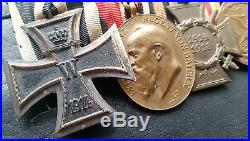
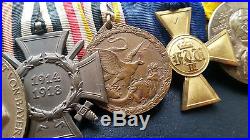
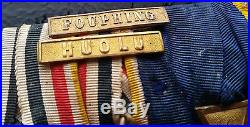
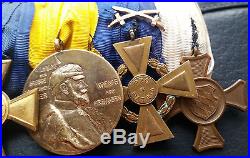
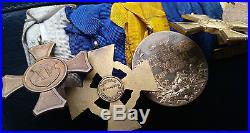
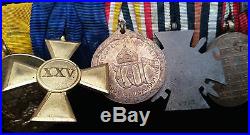
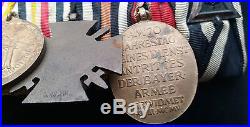
Original German mounted medal group: Iron Cross II. Class, Bavarian Army Jubilee Medal, Honour Cross With Swords, China Campaign Medal for Combatants with two clasps: “FOUPHING” & “HUOLU”, Prussian Long Service Cross for Officers for 25 Years’, Prussian Centenary Medal. Commemorative Cross of the. Austrian Legion of Honour & Bavarian. Long Service Cross for Officers for 25 Years. WW1, VERY NICE CONDITION. GENUINE RIBBONS , THERE IS NO PIN DEVICE AT THE BACK, the Iron Cross is a three piece construction example with magnetic core, the Honour Cross is magnetic, maker: “KM & F”, NICE RARE GROUP – HARD TO FIND. Iron Cross (German: Eisernes Kreuz) was a military decoration of the Kingdom of Prussia, and later of Germany, which was established by King Friedrich Wilhelm III of Prussia and first awarded on 10 March 1813 in Breslau. In addition to during the Napoleonic Wars, the Iron Cross was awarded during the Franco-German War, the First World War, and the Second World War. The Iron Cross was normally a military decoration only, though there were instances of it being awarded to civilians for performing military functions. Two examples, the civilian pilot Hanna Reitsch was awarded the Iron Cross First Class for her bravery as a test pilot during the Second World War and Melitta Schenk Gräfin von Stauffenberg (also a German female test pilot) was awarded the Iron Cross Second Class. The Iron Cross was also used as the symbol of the German Army from 1871 to 1915, when it was replaced by a simpler Greek cross. In 1956, the Iron Cross became the symbol of the Bundeswehr, the German armed forces. The traditional design is black and this design is used on armored vehicles and aircraft. A newer design in blue and silver is used as the emblem in other contexts. The Iron Cross is a black four-pointed cross with white trim, with the arms widening towards the ends, similar to a cross pattée. It was designed by the neoclassical architect Karl Friedrich Schinkel and reflects the cross borne by the Teutonic Knights in the 14th century. The ribbon for the 1813, 1870 and 1914 Iron Cross (2nd Class) was black with two thin white bands, the colours of Prussia. The noncombatant version of this award had the same medal, but the black and white colours on the ribbon were reversed. Initially the Iron Cross was worn with the blank side out. This did not change until 1838 when the sprig facing could be presented. Since the Iron Cross was issued over several different periods of German history, it was annotated with the year indicating the era in which it was issued. For example, an Iron Cross from the First World War bears the year “1914″, while the same decoration from the Second World War is annotated “1939″. The reverse of the 1870, 1914 and 1939 series of Iron Crosses have the year “1813″ appearing on the lower arm, symbolizing the year the award was created. The 1813 decoration also has the initials “FW” for King Frederick William III, while the next two have a “W” for the respective kaisers, Wilhelm I and Wilhelm II. The final version shows a swastika. It was also possible for a holder of the 1914 Iron Cross to be awarded a second or higher grade of the 1939 Iron Cross. In such cases, a “1939 Clasp” (Spange) would be worn on the original 1914 Iron Cross. A similar award was made in 1914 but was quite rare, since there were few in service who held the 1870 Iron Cross. For the First Class award the Spange appears as an eagle with the date “1939″ that was pinned above the Cross. Although two separate awards, in some cases the holders soldered them together. A cross was the symbol of the Teutonic Knights (a heraldic cross pattée), and the cross design (but not the specific decoration) has been the symbol of Germany’s armed forces (now the Bundeswehr) since 1871. The Iron Cross was founded on 10 March 1813 in Breslau and awarded to soldiers during the Wars of Liberation against Napoleon. It was first awarded to Karl August Ferdinand von Borcke on 21 April 1813. King Wilhelm I of Prussia authorized further awards on 19 July 1870, during the Franco-German War. The Iron Cross was reauthorized by Emperor Wilhelm II on 5 August 1914, at the start of the First World War. During these three periods, the Iron Cross was an award of the Kingdom of Prussia, although given Prussia’s pre-eminent place in the German Empire formed in 1871, it tended to be treated as a generic German decoration. The 1813, 1870, and 1914 Iron Crosses had three grades: Iron Cross 2nd Class German: Eisernes Kreuz 2. Klasse, Iron Cross 1st Class German: Eisernes Kreuz 1. Klasse, Grand Cross of the Iron Cross (German: Großkreuz des Eisernen Kreuzes, often simply Großkreuz). Although the medals of each class were identical, the manner in which each was worn differed. Employing a pin or screw posts on the back of the medal, the Iron Cross First Class was worn on the left side of the recipient’s uniform. The Grand Cross and the Iron Cross Second Class were suspended from different ribbons. The Grand Cross was intended for senior generals of the German Army. The medal was awarded on the occasion of the 70th anniversary of his entry into the Bavarian Army by Prince Regent Luitpold. It was awarded to serving officers, non-commissioned officers and military officials (Militärbeamten), to officers of the Reserve and Territorial Army (Landwehr) and to holders of the Gold and Silver Military Merit Medal. In all, just over twenty-two thousand medals were struck at the Bavarian Mint and the medal is thus quite hard-to-find. Cross of Honor, a. Hindenburgkreuz, Frontkämpferehrenkreuz (Ehrenkreuz des Weltkrieges 1914/1918) – Ehrenkreuz des Weltkrieges 1914/1918 was instituted on July 13, 1934 by the President Generalfeldmarshall Paul von Hindenburg aiming to commemorate all those who fought and fell during the Great War and therefore was nicknamed Hindenburg Cross. Cross of Honor was awarded to frontline veterans and non-combatants German citizens and Germans who lost their citizenship due to the Versailles Peace Treaty as well as to relatives of the fallen soldiers their widows and parents. Thus it aim was to reinforce pride not only in veterans but also military personnel of German Armed forces. Cross of Honor was instituted in three classes: 1. Cross of Honor for frontline soldiers (Ehrenkreuz für Frontkämpfer). It was awarded only for the military personnel of the Imperial Army and Navy who had engaged the enemy in frontline combat. Cross of Honor for war participants, i. Non-combatants (Ehrenkreuz für Kriegsteilnehmer). It was awarded to military auxiliary personnel such as administrators and medics, as well as to civilians state officials, etc. Cross of Honor for next-of-kin (Ehrenkreuz für Hinterbliebene). It was issued to widows and parents of those who were killed or died during WWI or were missing in action. Award was issued after an application accompanied by a prove of wartime service or loss of a relative was approved by the authorities, the Reichsminister of interior being in charge of the distribution of crosses. Cross of Honor was handed personally to the active military personnel and sent by post to veterans and civilians. Ehrenkreuz des Weltkrieges was created by Eugene Godet who received commission from the Reich Chancellery and its design was based on that of the Prussian Kriegsdenkmünze für die Feldzüge 1870/1871 Kriegsdenkmünze für die Feldzüge 1870/1871 reverse. It had a form of an equilateral 37×37 mm Teutonic cross with a 1 mm raised edge line and a recessed field. Two dates referring to the Great War were placed over each other in the central medallion 1914 and 1918. The upper arm of the cross had a 1,5-2 mm ribbon ring through which a ribbon loop ran. Three classes of the Honor Cross differed by the following details. Cross of Honor for frontline soldiers made of bronze or bronzed iron had a wreath of laurels on the center, tied at the base by a ribbon tie with the ends extending to the lower arm of the cross. The wreath was composed of five bunches of three leaves on each side, with a pair of laurel berries at each joint. A pair of 41 mm crossed swords were placed through the arms of the cross. Tricolor 25-30 mm ribbon featured central red stripe and black and white stripes on both sides accompanied by thin black stripes closer to both edges. Sometimes a crossed swords gilt device was worn on the ribbon. Cross of Honor for war participants made of bronze or bronzed iron was of a nearly similar design but had a wreath of oak leaves and lacked swords. Its ribbon was similar to that of the Cross of Honor for frontline soldiers. Cross of Honor for next-of-kin was similar to the Cross of Honor for war participants but was finished in black and its ribbon colors were inverted, i. Central red stripe and white and black stripes on both sides accompanied by thin white stripes closer to both edges. Its worth mentioning here that though award documents for the Cross of Honor for next-of-kin were of two different types (Ehrenkreuz für Witwen and Ehrenkreuz für Eltern) the award itself was only of one type as described above. The rarest type of the Cross of Honor for next-of-kin was made of iron and had a horizontal pin and catch on its reverse instead of ribbon ring that was missing. All three classes of the award had a flat reverse with makers mark. Ehrenkreuz des Weltkrieges was made of bronze or iron. The Cross of Honor was worn mounted as part of a group or on the ribbon bar. The award ranked above service and occupation medals but below combat related awards. Number of awards: Ehrenkreuz für Frontkämpfer 6,202,883 pieces, Ehrenkreuz für Kriegsteilnehmer 1,120,449 pieces, Ehrenkreuz für Hinterbliebene 345,112 pieces issued to widows with Ehrenkreuz für Witwen award document and Ehrenkreuz für Hinterbliebene 372,950 pieces issued to parents who lost their sons with Ehrenkreuz für Eltern award document. The medal was instituted on 10 May 1901 in bronze for combatants and those who had tended the sick and wounded in the war zone and in steel for non-combatants and support personnel. It was awarded for those who between 30 May 1900 and 29 June 1901 were numbered amongst either the German marines and civilians who took part in the defence of the Foreign Legations in Peking (Beijing) during the two and a half months siege by the Boxers or the German soldiers, marines and sailors who lifted the siege. The proposal of Emperor Wilhelm II for a common commemorative medal for the eight-nation alliance was rejected and each country (except Austria-Hungary) issued its own medal. The medal was designed by Professor Walter Schott of Berlin and manufactured by Mayer and Wilhelm of Stuttgart. The alliance fielded a force numbering 54,000 of whom 300 were German soldiers and 600 German marines with five German warships giving support. The small size of the German force makes this medal relatively rare. Prussian Long Service Cross for Officers for 25 years service Dienstauszeichnungskreuz für Offiziere für 25 Jahre – Gilt bronze cross pattée with stippled arms, with laterally-pierced loop for ribbon suspension; the face with a circular central medallion bearing the crowned cipher of King Friedrich Wilhelm III; the reverse with a circular central medallion bearing the Roman numerals XXV. (= 25); gilding age-faded; on replaced correct ribbon. The award was instituted on 18 June 1825 by King Friedrich Wilhelm III to reward long and faithful service. It was suppressed in 1920 after the abolition of the Prussian monarchy at the end of World War I. Prussian 1897 Centenary Medal (Zentenarmedaille) was officially titled the Medaille zur Erinnerung an des Hochseligen Kaisers und Königs Wilhelm I. Des Großen, Majestät to honor the 100th Birthday of Kaiser Wilhelm I. The recipients promptly dubbed it the Apfelorden (The Order of the Apple, due to it’s size and color). Modern German collectors often call it the Zitronorden (The Order of the Lemon, again due to it’s size and color and partly because they forget the name Apfelorden). The medal was designed by Professor Walter Schott and was made by the firm of L. The obverse shows a raised relief profile portrait of Kaiser Wilhelm I with the inscription WILHELM DEM GROSSE DEUTSCHER KAISER KOENIG VON PREUSSEN (Wilhelm the Great, German Emperor and King of Prussia). The reverse has the raised relief inscription ZUM ANDENKEN AN DEN HUNDERSTEN GEBURTSTAG DES GROSSEN KAISERS WILHELM I. 1797-22MAERZ-1897 In Rememberance of the Hundredth Birthday of the Great Emperor Wilhelm I. A design of a laurel leaf spray, oak leave branches, crown, scepter, orb, Bible, and sword arcs from the 3:30 to 11:00 position. The original silk ribbon is plain yellow (representing gold) which varies in width from 3cm +/. 5cm (depending on the maker). This award is a military decoration of an ex-service men’s organisation, unlikely to be government issue. Obverse description: bronze cross supported by laurel wreath with central medallion bearing text – “PRO PATRIA” (For the Fatherland). Date Issued: since 1918. Overall Dimensions 40 mm (Width), 45 mm (Height). Bavarian 15-Year Military Long Service Cross (Bayern 15 Jahre Dienstauszeichnung) was instituted in 1913 to replace the Militär Dienstauszeichnung Schnalle 2. It was awarded to military active duty NCO’s and enlisted personnel for 15 years active service and required the recommendation of their Commanding Officer. This medal was instituted by Prinz Regent Ludwig on 30th August 1913 and awarded by 1919. These are often found in WWI German medal groups and helps identifying the recipient as a Bavarian. The 15-Year Long Service Cross was made of a metal similar to a bronzed brass (the exact metal alloy was varied but the finishing techniques left a flat golden color) with a flat ring loop soldered on for the suspension through which a blue silk woven ribbon (UV-negative, usually 32-35 mm wide) is worn. The Cross size varied over the years at around 43-44. Both sides of the Cross have a small edged border. The obverse had the Bavarian coats of arms centered within a circle in the middle of the Cross. The reverse carried only a XV within a circle, which represented 15 years. The item “7192 German WW1 mounted medal group Iron Cross China Medal Bavarian Medals” is in sale since Friday, April 20, 2018. This item is in the category “Collectables\Militaria\World War I (1914-1918)\Medals/ Ribbons”. The seller is “a..anderson” and is located in Abbots Langley. This item can be shipped worldwide.
- Type: Medals & Ribbons
- Era: 1914-1945
- Conflict: World War I (1914-1918)
- Country/ Organization: Germany